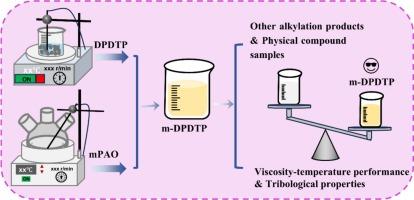Phosphorus- and sulfur-incorporated chemical modification of metallocene poly-α-olefin for dual-functional base oils with enhanced antioxidant and antiwear performance
IF 6.3
2区 化学
Q1 POLYMER SCIENCE
引用次数: 0
Abstract
The performance demands of mechanical lubricants are intrinsically linked to the operational reliability, efficiency, and service life of machinery, encompassing critical aspects such asextreme condition adaptability, long-term stability, and environmental compatibility. However, conventional lubricants exhibit limitations in fulfilling these multifaceted operational requirements. In this study, we developed a bifunctional metallocene-catalyzed polyalphaolefin (mPAO) base oil integrating antioxidant and antiwear characteristics. Two sulfur-phosphorus additives—diphenyldithiophosphoric acid phenyl ester (DPDTP) and butyl phosphorothioate derivative (BPSD)—were synthesized. A series of functionalized mPAO alkylation products were successfully prepared by grafting selected organophosphorus compounds onto mPAO via alkylation. Oxidation stability was assessed through pressurized differential scanning calorimetry (PDSC) and thermogravimetric analysis (TGA). Compared with mPAO, m-DPDTP demonstrated remarkable antioxidant enhancement, exhibiting a 74 °C higher initial oxidation temperature and a 61.6 °C increase in onset decomposition temperature. Tribological performance was systematically investigated using four-ball wear tests, UMT tribometer measurements, and TE77 reciprocating friction evaluations. The m-DPDTP exhibited reductions in average friction coefficients of 35.91 %, 56.85 %, and 47.78 %. Additionally, a 56.85 % reduction in wear scar diameter was observed during the four-ball evaluations. Additionally, m-DPDTP demonstrated the highest PB (212 N) and PD (250 N). These findings substantiate that DPDTP-grafted alkylation products possess superior friction reduction, antiwear capabilities, and extreme-pressure performance. This work establishes a molecular engineering strategy combining structural design and composite modification to develop mPAO alkylation products with concurrent thermal-oxidative stability and tribological enhancement. This breakthrough overcomes the functional singularity of conventional base oils and provides a novel paradigm for advanced lubricant formulation.

磷硫化学改性茂金属聚α-烯烃的抗氧化和抗磨双重功能基础油
机械润滑油的性能要求与机械的运行可靠性、效率和使用寿命有着内在的联系,包括极端条件适应性、长期稳定性和环境兼容性等关键方面。然而,传统润滑油在满足这些多方面的操作要求方面表现出局限性。在这项研究中,我们开发了一种双功能的茂金属催化的聚α -烯烃(mPAO)基础油,集抗氧化和抗磨特性于一体。合成了二苯基二硫代磷酸苯酯(DPDTP)和硫代丁酯衍生物(BPSD)两种硫磷添加剂。将选定的有机磷化合物通过烷基化接枝到mPAO上,成功地制备了一系列功能化的mPAO烷基化产物。氧化稳定性通过加压差示扫描量热法(PDSC)和热重分析(TGA)进行评估。与mPAO相比,m-DPDTP表现出明显的抗氧化增强,其初始氧化温度提高74℃,起始分解温度提高61.6℃。通过四球磨损测试、UMT摩擦计测量和TE77往复摩擦评估,系统地研究了摩擦性能。m-DPDTP的平均摩擦系数分别降低了35.91%、56.85%和47.78%。此外,在四球评估期间,观察到磨损疤痕直径减少了56.85%。此外,m-DPDTP表现出最高的PB (212 N)和PD (250 N)。这些发现证实了dpdtp接枝的烷基化产物具有优异的减摩、抗磨能力和极压性能。本工作建立了结合结构设计和复合改性的分子工程策略,以开发同时具有热氧化稳定性和摩擦学增强的mPAO烷基化产物。这一突破克服了传统基础油的功能单一性,为先进的润滑油配方提供了一个新的范例。
本文章由计算机程序翻译,如有差异,请以英文原文为准。
求助全文
约1分钟内获得全文
求助全文
来源期刊

European Polymer Journal
化学-高分子科学
CiteScore
9.90
自引率
10.00%
发文量
691
审稿时长
23 days
期刊介绍:
European Polymer Journal is dedicated to publishing work on fundamental and applied polymer chemistry and macromolecular materials. The journal covers all aspects of polymer synthesis, including polymerization mechanisms and chemical functional transformations, with a focus on novel polymers and the relationships between molecular structure and polymer properties. In addition, we welcome submissions on bio-based or renewable polymers, stimuli-responsive systems and polymer bio-hybrids. European Polymer Journal also publishes research on the biomedical application of polymers, including drug delivery and regenerative medicine. The main scope is covered but not limited to the following core research areas:
Polymer synthesis and functionalization
• Novel synthetic routes for polymerization, functional modification, controlled/living polymerization and precision polymers.
Stimuli-responsive polymers
• Including shape memory and self-healing polymers.
Supramolecular polymers and self-assembly
• Molecular recognition and higher order polymer structures.
Renewable and sustainable polymers
• Bio-based, biodegradable and anti-microbial polymers and polymeric bio-nanocomposites.
Polymers at interfaces and surfaces
• Chemistry and engineering of surfaces with biological relevance, including patterning, antifouling polymers and polymers for membrane applications.
Biomedical applications and nanomedicine
• Polymers for regenerative medicine, drug delivery molecular release and gene therapy
The scope of European Polymer Journal no longer includes Polymer Physics.
 求助内容:
求助内容: 应助结果提醒方式:
应助结果提醒方式:


